Breeding
Adélies concregate at breeding sites, known as colonies, in the Antarctic summer.
- Breeding takes place between October and February each year.
- Young Adélies don't visit breeding colonies until they're 2 to 4 years old. Initial visits are to claim a nest site.
- Adélies first breed at 3 to 6 years of age. The average is 5 years for females and 6 for males.
- 96% of Adélies return to their natal colony (where they were born), to breed for the first time. Most (67%) nest within 200 m of where they were born. This strong tendency is called natal philopatry. Some individuals do move to other or new colonies, however.
- Nesting occurs in noisy communal colonies of between 100 to 250 000 pairs.
- Colonies are located close to regions like polynyas and local up-wellings that provide accessible food.
- To avoid problems with snow and melt-water, nests are built of small stones on sloping ice-free ground.
- Parents share the job of raising chicks almost equally.
- Up to 40 foraging trips are needed by parents to raise a single chick.
- Fecundity of breeding pairs averages 0.9 chicks/year.
- Up to 10% of chicks are not sired by the attending male.
Breeding cycle
Birds arrive at their colony, usually an ice and snow-free headland, spit or island around the Antarctic coastline. Males usually arrive first during mid- to late-October to claim nest sites and begin nest construction.
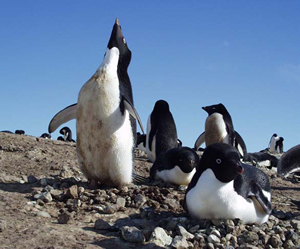 |
Nest building The nest consists of a simple platform of small stones and rock chips. These are frequently added-to during incubation, and are often stolen from neighbouring nests. Stones allow good water drainage; cold and wet eggs or chicks quickly die. |
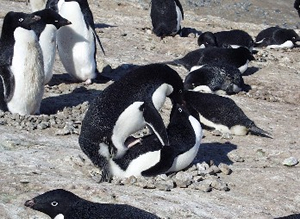 |
Pair formation Pair bonding is accompanied by loud mutual displays. After copulation (the male bird stands on the female's back and transfers sperm to her cloacca), the eggs are fertilised and laid a few days later. |
|
Egg laying Egg laying takes place in late November to early December. Normally a single clutch of two eggs is laid over 2 to 3 days. A third egg may be laid if the first is lost. Eggs are white, about 72 mm long, 55 mm wide and weigh about 120 g; similar to a large hen's egg. |
|
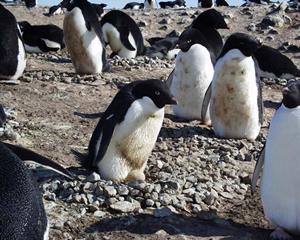 |
Incubation Usually the male (85% of the time) incubates for the first 2 weeks while the female is at sea. He will have fasted for nearly a month at this stage! Turns on the nest alternate after the female returns, with shorter and more frequent spells at sea. Up to 70% of eggs laid will hatch over a 4-week period around late December. The second egg hatches about one day after the first. Chicks have a large yolk sac within the body cavity so they can last for a few days while waiting for the parent at sea to return with their first meal. |
 |
Guarding Chicks gather together in large groups for protection and warmth as both parents are now busy collecting food for their rapidly growing chicks. Individual chicks chase their parents when they return from sea, noisily begging for food, which the parents regurgitate. Meal size is now up to 650 g. This period lasts for the next 25 to 35 days. |
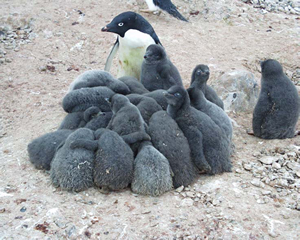 |
Crèching Chicks gather together in large groups for protection and warmth as both parents are now busy collecting food for their rapidly growing chicks. Individual chicks chase their parents when they return from sea, noisily begging for food, which the parents regurgitate. Meal size is now up to 650 g. This period lasts for the next 25 to 35 days. |
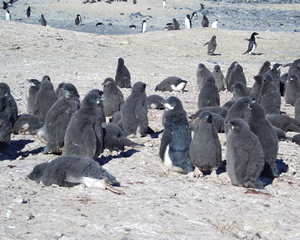 |
Chick moulting As the chicks develop they loose their soft down, which is replaced with waterproof feathers. After 50 days the birds are nearly fully feathered. |
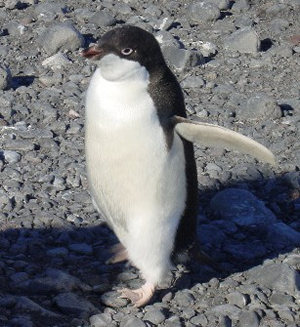 |
Fledging At the end of January the adults stop feeding their chicks. From this point on the chicks have to fend for themselves, learning to swim and catching their own food. Chicks have short swims for a day or two before leaving the colony in early to mid-February. |
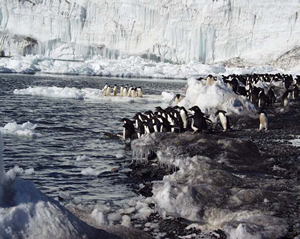 |
Adult moulting After the chicks fledge, the adults need to regain condition so they can cope with moulting. Most adults and juveniles moult over a period of 2 to 3 weeks in the pack ice. They don't feed at this time. Adélies winter in the outer edge of the pack ice near the Antarctic Convergence. |
